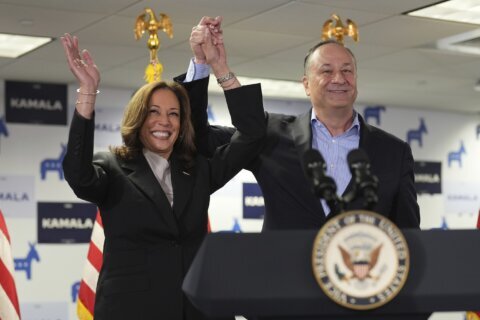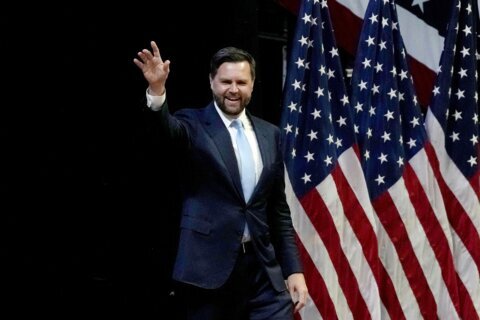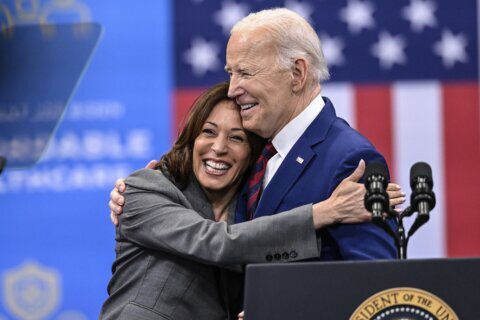Look, it’s happened to all of us: We’ve been in a meeting for what feels like forever, so we all decide to agree on something that has a little bit of everyone’s idea, just to get out of there.
Sometimes, it results in ridiculous projects that are forgotten quickly. Other times, it results in a system for picking a president that lasts more than 200 years.
That’s right — the Electoral College was a last-minute “hydraulic balancing act” by a group of tired people who a history professor says were “puzzled” after working all summer without a model for what they wanted to do.
First, a brief recap of the way the winner of next month’s election will be determined: You’re not really voting for a president, but for a slate of electors from your state (or D.C.) to join the Electoral College, who then go on to vote for a presidential candidate. The size of each state’s slate of electors is based on its congressional representation — how many House members it has, plus two more for the two senators each state (except D.C.) has.
The Electoral College goes on to meet Dec. 14 to cast the real votes for president, which are counted by Congress Jan. 6, in time for Inauguration Day Jan. 20. And of course, there is plenty time for legal challenges in between each of these steps.
This is, naturally, not the way virtually any other election in the U.S. is run. And as we’ve seen, it can result in a president who got fewer votes than another candidate, which really isn’t the principle most American elections run on. So why is it this way, and why hasn’t it ever been changed?
Interactive map: Can you predict the outcome of the 2020 presidential election?
‘Fatigue and haste’
Alex Keyssar, a professor of history and social policy at the Kennedy School of Government at Harvard University, seemed like the right guy to ask why we still have the Electoral College: He’s the author of “Why Do We Still Have the Electoral College?”
But first off: Why did we ever have the Electoral College?
“Fatigue and haste,” Keyssar said. When he looked back on the work of the framers of the Constitution, “James Madison, writing in the 1820s, himself, observed that the Electoral College was not the best work that they had done.”
The framers had been working all summer on the Constitution, and it was August in Philadelphia when they decided they needed a break, Keyssar said. So they left the question of how to pick the president, as well as a few others, to the aptly named Committee on Postponed Parts.
And the Electoral College was what they eventually came up with, adding two other provisions: If no candidate gets a majority of the Electoral College, the election goes to the House of Representatives, with each state getting one vote. It’s also not written in stone anywhere that each state’s electors have to go to the winner of the vote; a state’s legislature can pick the slate.
‘A replica of Congress’
So who thought that was a good idea?
Keyssar said the framers considered a national popular vote — Madison’s preferred option — as well as having the governors choose the president.
But the leading idea — “the default position” — was that Congress would choose the president. The problem was, that opened up the possibility that the chief executive wouldn’t be truly independent — “you wouldn’t really have separation of powers.”
In the end, they created the Electoral College to reflect the Congress idea: “In effect, the Electoral College is a replica of Congress,” Keyssar said.
It also was in line with their previous thinking. “[It] imported into the presidential selection process the compromises that they had worked out earlier in the summer with respect to representation in Congress — that’s to say, the compromises between large states and small states, and between slave states and free states,” Keyssar said.
While the effect of the establishment of the Electoral College was a proportional overrepresentation of small states, and that included slave states, Keyssar said, “I’m not as convinced, as some people have been, that slavery was integral to the intentions of the framers when they designed this system. They had already decided to make their peace with it, so to speak, and they used the same system for presidential elections.”
The framers got two things very wrong, Keyssar said: They didn’t realize that political parties would exist, eventually crowding the presidential field into a two-candidate race, so some of them thought the House of Representatives would end up picking the president anyway.
It’s also possible they didn’t realize how much it would matter: “They all knew that George Washington would be the first president,” Keyssar said.
Right off the bat
That was in 1787; by 1800, people were already clamoring to change the system after that year’s election took 36 tries to resolve in the House, as well as after the 1824 election, when the House again ended up deciding the election, this time a free-for-all among four candidates from the same party(!).
Of course, changing or deleting the Electoral College requires an amendment to the Constitution, and that isn’t easy: Two-thirds of both houses of Congress, then three-quarters of the individual states’ legislatures. Hundreds of amendments to eliminate the Electoral College, or basically render it meaningless by ending the winner-take-all system for states to award their electoral votes, were offered in the 19th century, and four times it passed the Senate, Keyssar said.
Efforts to get rid of the Electoral College really took off during the late 1960s and early 1970s, Keyssar said, for several reasons — including the democratizing influence of the civil rights movement.
“[There was] a series of Supreme Court cases with respect to Congress and state legislatures that say ‘You know, the principle of democracy is one person, one vote,'” Keyssar said. “And then, even though they weren’t talking about the Electoral College, well, people turned around an hour later and said, ‘What about the Electoral College? So that leads to mounting support.”
There were also some crowded elections — four viable presidential candidates in 1948, three in 1968.
“In both of those circumstances, there was fear that nobody would win a majority of the electoral votes, and that the third candidate in 1968, [the segregationist] George Wallace, would become a kingmaker and would basically be able to trade his electoral votes for concessions in policy.”
A proposed amendment to abolish the Electoral College passed the House easily in 1969, with 83% of the vote, but was filibustered by a group of Southern segregationist senators.
“Southern segregationists have pretty much always been opposed to national popular vote,” Keyssar said, “because of a feature of the Electoral College that we don’t often think about — the Electoral College gives states influence and electoral votes in proportion to its population, not in proportion to the number of voters.”
That feature made its first appearance in the notorious “three-fifths compromise,” which counted a slave as 60% of a human being in terms of congressional seats and electoral votes.
But in the post-slavery, Jim Crow South, the situation was actually worse, Keyssar said — Black people counted fully for representation and electoral votes, but were still kept by law from voting for the people who would fill those seats and cast those votes. He calls it “the five-fifths compromise.”
“Those patterns, those convictions, those ideas, persisted into the late 1960s and contributed strongly to the Southern filibuster,” Keyssar said.
‘Wrong result’
For decades, political observers believed that a “wrong result” electoral vote — one in which the popular-vote loser gained the White House because of a more efficient electoral distribution of his votes — would lead to a crisis of legitimacy for the new president, and an instant groundswell in support for reform.
But after two such results in the last five elections (with only one in history before that), that hasn’t been the case.
It’s sort of self-defeating: “Misfires of the Electoral College produced political crises,” Keyssar said, “but political crises often produce partisan rancor, which then makes it hard to amend the Constitution.”
While advocates of leaving the system alone claim that smaller and rural states would be left out of the presidential electoral process without the Electoral College, Keyssar pointed out that many reform leaders come from smaller and rural states. In reality, the Electoral College prioritizes swing states — states whose popular vote could go either way. In 2016, the group National Popular Vote said two thirds of campaign stops by the Donald Trump and Hillary Clinton campaigns were in the same six states.
And in 2015, Republican Gov. Scott Walker, of Wisconsin, said, “The nation as a whole is not going to elect the next president. Twelve states are.”
The chance for reform
After the 2000 election, where George W. Bush won the presidency despite getting fewer votes than former Vice President Al Gore, “The Republicans were absolutely firm that they wouldn’t go along with it,” Keyssar said, while “the Democrats were by no means unanimous in favor of Electoral College reform. I think Al Gore was not in favor of Electoral College reform. And people did not want to spend a lot of time and energy trying to promote something that was a sure loser.”
Nowadays, the National Popular Vote Interstate Compact is seen as the attempt at reform that has the best chance: Under the Constitution, state legislatures decide how to award their electors; since the mid-18th century, they’ve always gone to the state’s popular-vote winner, but they don’t have to. The compact an agreement among states that they will give their electoral votes to the national popular-vote winner, basically obviating the Electoral College. States totaling 270 votes — the majority needed to win — need to sign on; so far, the total is at 196.
“It’s an attempt to try to reform the system without passing a constitutional amendment,” Keyssar said.
Pat Rosenstiel, of National Popular Vote, said his group, begun in 2006, comprises “Democrats, Republicans, independents, conservatives, liberals and moderates who believe we should elect the president by national popular vote.” He said the problem with the Electoral College goes past the possibility that a candidate who gets fewer votes could become president.
“It’s about [how] every presidential election, there are battleground-state voters who have all the power and the rest of us are mere spectators.” He said that since this year’s presidential nominees in each party were decided, all campaign visits have been concentrated in 15 states and seven-eighths of all campaign spending has happened in 12 states.
“And, you know, if it was just about money and events, that’d be one thing. But it’s clearly a proxy for political influence with the president. And if you don’t believe me, Google ‘Joe Biden’ and ‘President Trump’ and ‘fracking’ and you think we were running a campaign for governor of Pennsylvania and not for president of the United States.”
He dismisses the argument that the Electoral College preserves the power of small states, saying it empowers only certain small states, and points to how governor’s races are conducted nationwide.
“Think about George Pataki, when he was elected and reelected governor in the state of New York,” Rosenstiel said — “he wasn’t doing that by winning the major population centers. He was campaigning all across the state of New York, which is obviously the model in every statewide election in every state. And we believe that will transfer over to a national popular vote election.”
He added, “In a national popular vote election, those smaller states, the rural voters, they represent one-sixth of the voters in this country. And it’s roughly equal to how many Americans live in urban centers. And so under a national popular vote system, it doesn’t matter if you come from a small state, big state, city, rural area, suburban, exurban — every American voter will be valued.”
Rosenstiel said he’s “increasingly optimistic that we’re suffering under the last campaign” with the Electoral College. That remains to be seen. But for now, the Electoral College system — the result of a long, drawn-out committee meeting in the 18th century — continues to influence our politics in the age of smartphones and space travel.
“There are numerous features of our political system that are imitated elsewhere in the world,” Keyssar said; “the Electoral College is not one of them. And in fact, it bewilders people from abroad — they don’t understand why we have this system.”








